People are obsessed with the latest and greatest and design tricks these days. There’s a proliferation of Mac OS X system and maintenance customisation utilities. Almost all of them are rendered redundant by Marcel Bresink’s functionalist TinkerTool and TinkerTool System.
TinkerTool offers a consistent interface to tweak OS X hidden preferences for over a decade now across a dozen OS X versions. You can count on Marcel Bresink and his team to find and safely share ways to tweak and customize OS X. TinkerTool is free. It’s companion TinkerTool System allows a user to easily perform advanced maintenance and is always an inexpensive purchase between €5 and €9. I recommend Bresink’s utilities over anything else as Bresink is dedicated just to these system level tweaking and is very careful to make sure the customisations he includes won’t break your OS. In TinkerTool System it’s easier to break the OS but you’ll be warned several times before you do so. The other customisation utilities are mostly fly-by-night or built by marketers not engineers. I’ve used TinkerTool and TinkerTool System without adverse incident for over ten years.
Many of the comments at MacUpdate suggest that TinkerTool is not compatible with their OS. TinkerTool as it directly works with system preferences is OS specific. You must download the version which matches your OS:
- For macOS 11 Big Sur, use TinkerTool. The program with the standard name TinkerTool is always designed to be compatible with the latest official version of Apple’s operating systems.
- For macOS 10.14 Mojave and macOS 10.15 Catalina, use TinkerTool 7.
- For macOS 10.12 Sierra and macOS 10.13 High Sierra, use TinkerTool 6.
- For OS X 10.9 Mavericks, OS X 10.10 Yosemite, and OS X 10.11 El Capitan, use TinkerTool 5.
- For Mac OS X 10.6 Snow Leopard, Mac OS X 10.7 Lion and OS X 10.8 Mountain Lion, use TinkerTool 4.
What are the kind of things one can do with TinkerTool?
- show and hide hidden files (there’s lots of utilities to do this and the command line works nicely as well:
defaults write com.apple.finder AppleShowAllFiles -bool YESbut also requires manually restarting finder. It’s also possible to write an automator script and make a contextual menu item to toggle hidden files. What’s new to me is that in open and save dialogues one can see hidden files with Command-Shift-. (dot). TinkerTool provides a consistent place to toggle - disable animations in the Dock and Finder. It’s less of an issue now on the current powerful graphic cards and processors but OS level animations used to steal a lot of GPU memory for no purpose and slow down basic operations.
- set OS X to offer expanded open/save dialogues by default. Personally I find the small open/save dialogues almost useless so I’m happy to have a way to get the normal full size open/save dialogue by default.
- set Help window free to not sit on top in the foreground
- deactivate Dashboard (if it’s always popping up and getting in your way)
- stop TimeMachine for asking to create backups on every drive you insert.
- not prefer iCloud for saving documents (yes really it’s a default, I don’t use iCloud so I don’t run into this)
- customise fonts for applications and font sizes for the system
- control font smoothing (important for non-Retina screens)
- control where dark mode appears. For example one could use Dark Mode but exempt the Finder and System Preferences.
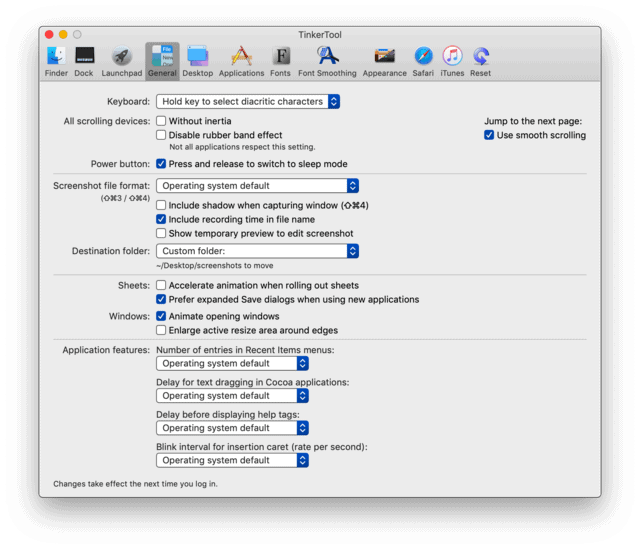
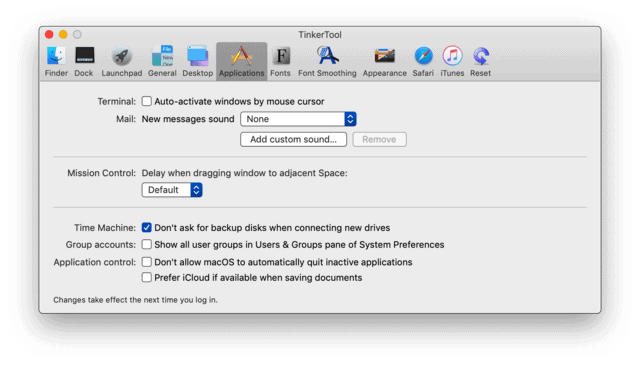
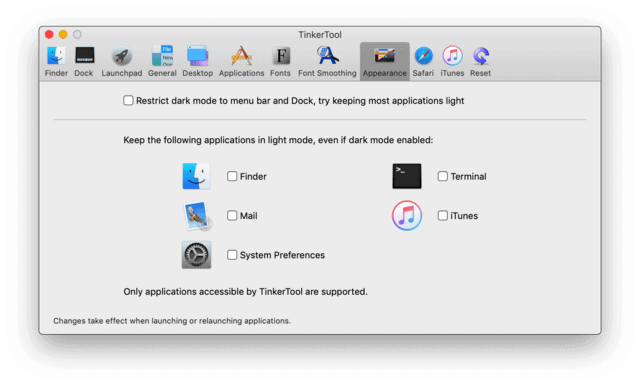
TinkerTool is free so there’s no downside here. If there’s even one thing on the list above you’d like to be able to customise (and I’ve only listed about a quarter of the features), TinkerTool makes it free and easy to have OS X behave the way you want your OS to behave, not Tim Cook. As Apple continues to lower the bar for the average expected IQ of its users, being able to make the OS behave in an intelligent way with fewer silly animations and more advanced functionality is important.
In case you’re ever not happy with your customisation, there’s even a full reset button which will set all these preferences back to OS X defaults.
Thank you Marcel Bresink for making computing on Apple better!
Tinker Tool System
TinkerTool System allows an advanced user some control over colour schemes as well as the ability to flush persistent caches. Control over cache can be very important to repair system performance. Advanced control over Spotlight is a care feature. There’s a screen to show which of your SSD are using trim. TinkerTool 2 also allows users to create portable install disks for OS X. This is again easily enough done via terminal but it’s nice to have a reliable GUI.
There’s a screen which shows which of your apps are blacklisted by OS X for App Nap, Retina display or from launching at all. I was astonished to find I have 98 such applications installed. It’s not entirely accurate as I am able to launch Adobe After Effects CS 6. There’s a driver blacklist which lists 52 kexts on my computer which are blacklists. Most of them are not actively installed.
There’s advanced logs management. Basically a log reader which allows you to choose time range with a GUI interface and the information level.
- There’s advanced control of the printing system including making the web version visible (underpinnnings are Unix).
- You can even fix the persistent issue with a Mac deciding that it’s primary language is a different one. I have this issue with some of my Macs bought in Austria not wanting to give up German as their primary language.
- change default language for specific applications (if you always use a certain application in French or Russian or Chinese, you could set it to launch in that language).
- You can add Sleep as an option in the wake up dialogue (which I’m about to add as sometimes I accidentally wake my desktop and would like to just put it back to sleep without logging in).
- Easily add and remove words from the spell checker database (only your own additions of course).
- Repair System Preferences and Help Viewer.
- Maintain Spotlight Indexes, including seeing their size. On my Startup Disk, the Spotlight Index is 3.9 GB which seems much too large as my other drives full of photos have Spotlight indexes which are only 200 MB large.
The biggest issue with TinkerTool System is knowing what it does and finding the controls you need when you need them. Fortunately there’s a search on the top right which can quickly guide you to the section you need.
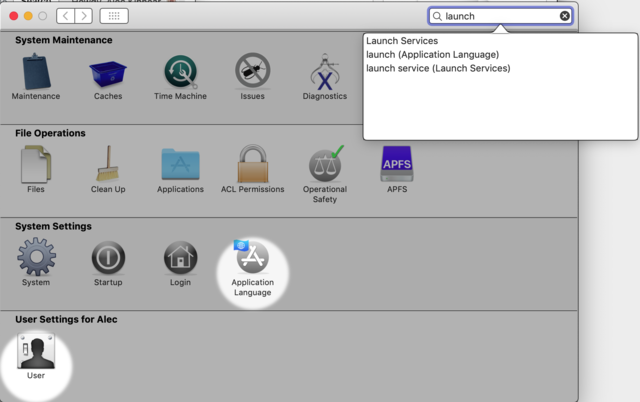
There’s at least €150 of paid utilities in TinkerTool System and twenty different applications. The first time you license TinkerTool System it will cost $14 and after that updates are $7. TinkerTool System is on version 7, expect to have to buy a new version on average every other Apple OS update.
I have only one major criticism of TinkerTool System which is that license must be purchased via Digital River. Digital River are the crooks who invented “backup insurance” for software licenses, where if you ever wanted to download your software again in the future you had to pay another fee up front, about thirty per cent of the cost of the software. Frankly it’s up to software merchants to keep records of their client licenses, as well as copies of major versions available. The cost of accessing those downloads and a license resend are part of the original price. If a software developer doesn’t want to play by those rules, s/he should be out of business.
Moreover the Digital River privacy policy is about ten pages and quite confusing. Giving US-based Digital River control of your customer data is a privacy violation all by itself, particularly for a European merchant. To purchase TinkerTool System it’s necessary to agree to all of these terms. There’s no reason a customer should have to create a separate agreement and separate account with a simple payment provider to pay Bresink for their software.
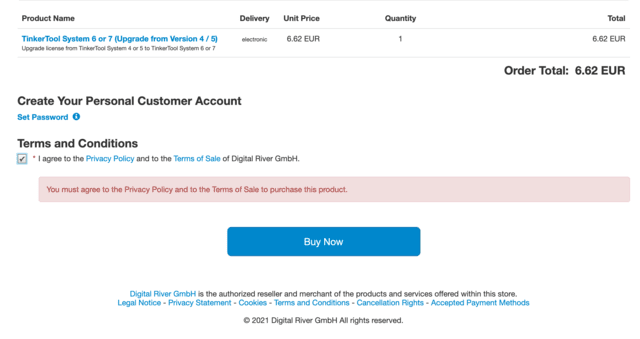
Digital River as a payment provider has stopped me from paying for an upgrade TinkerTool System a couple of times. Instead I’ve taken advantage of the five free runs of TinkerTool System and just used it infrequently to avoid having anything to do with Digital River.
Marcel Bresink you owe it to yourself and your clients to use a more customer-friendly and less crooked payment provider than Digital River.

Alec Kinnear
Alec has been helping businesses succeed online since 2000. Alec is an SEM expert with a background in advertising, as a former Head of Television for Grey Moscow and Senior Television Producer for Bates, Saatchi and Saatchi Russia.
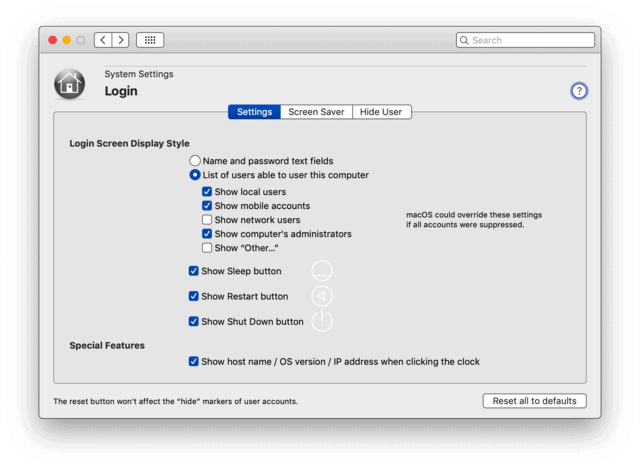
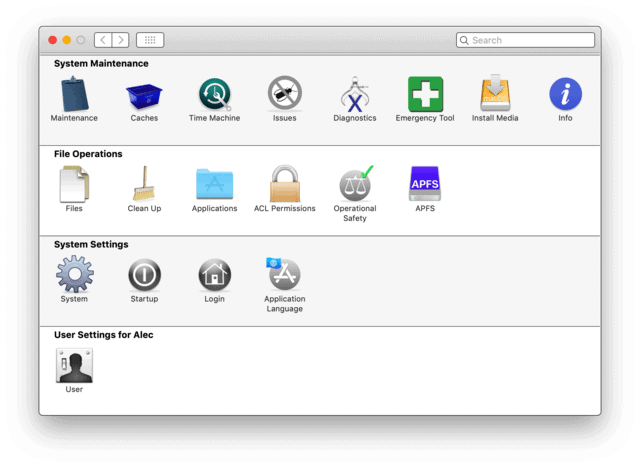
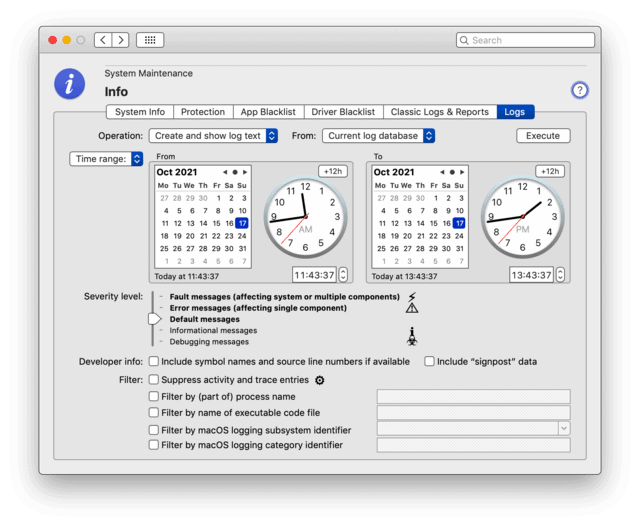
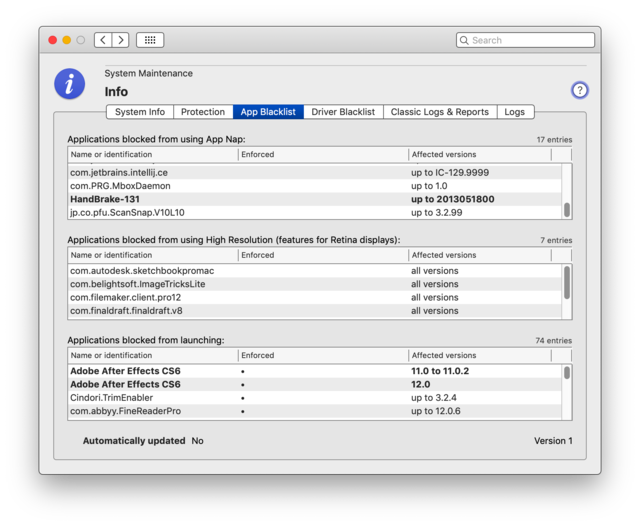
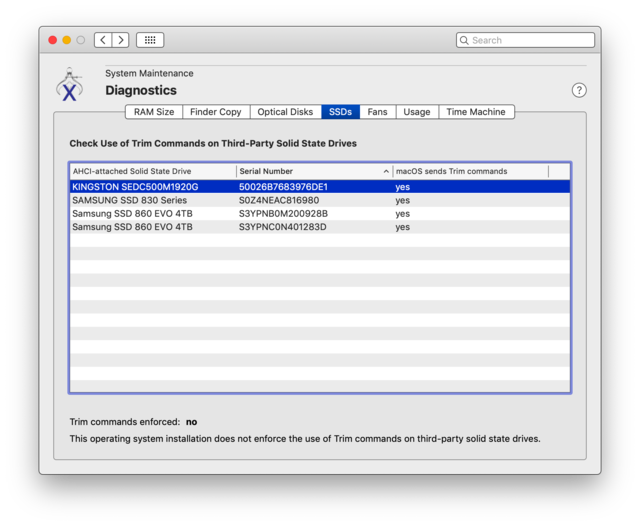
Leave a Reply